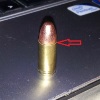WolverineFury
Member
Howdy all. So, yesterday, about a year after I first decided that I wanted to reload, I have finally set up my press, got my components, and churned out my first 50* rounds of 9mm last night. But before I go out and shoot them I'd like to ask all you seasoned reloaders if there is anything in what you see here which may be unsafe/may require change.
So here is my load data.
Powder used: Alliant Bullseye - 3.6 grains (Taken from MidwayUSA 9mm LoadMap pg. 44)
Bullet used : 115 gr TMJ RN 9mm from Rockey Mountain Reloading
Primers used: Small Pistol Primers No. 100 from Federal
Overall case length : 1.151 inches +/- a few thousandths.
The Cases were all brass. I inspected them all by rotating them in my fingers under light and found nothing more than a small scratch marks mostly from the extractor. These cases "passed" my inspection.
The ammo was all loaded with the 3 set Lee Carbide dies on the Lee 4 Hole Turret Press. The Powder was poured with the Auto Disk Powder Measure.
*The first 5 - 10 rounds I pulled with a kinetic puller since I was working on getting my seating depth right (they were initially seating at about 1.131) . When doing this I found that the bullets had a very pronounced ring around them similar to this (thought not quite as bad) - (this is just a photo I got off of google image, sorry it's so big)

Of course, this was before I had the bullet seater die fully adjusted. Now it leaves only a very slight ring around the bullet and seats at a OAL of 1.151".
Is this anything to worry about/the needs changed either way? What effect might this have on pressures? In both cases the case measured .378 where it meets the bullet. Also I went ahead and used those bullets with the highly defined rim again on the new setting. Should I not have done that?
As far as the actual process goes I measured the overall case length of probably 15 out of the 50 finished rounds and they were all measuring within 3 thousandths of an inch either way. Acceptable?
I was measuring the weight of the powder charge aprox' every 4 rounds. I was getting charges never exceeding .1 grain either way. Acceptable?
Another question about brass. After seating the bullet I noticed a shiny rim where the case meets the bullet. Once again, anything that needs changed here? What does it signify?

Thanks in advance everyone. Sorry for all of the nitpicking questions. I figured that you can be too careful though.
P.S. I noticed when measuring the OAL for several different factory rounds that I own, that some measure 1.113" while others measure 1.170". Is the powder used what causes such a wide range in the OAL?
So here is my load data.
Powder used: Alliant Bullseye - 3.6 grains (Taken from MidwayUSA 9mm LoadMap pg. 44)
Bullet used : 115 gr TMJ RN 9mm from Rockey Mountain Reloading
Primers used: Small Pistol Primers No. 100 from Federal
Overall case length : 1.151 inches +/- a few thousandths.
The Cases were all brass. I inspected them all by rotating them in my fingers under light and found nothing more than a small scratch marks mostly from the extractor. These cases "passed" my inspection.
The ammo was all loaded with the 3 set Lee Carbide dies on the Lee 4 Hole Turret Press. The Powder was poured with the Auto Disk Powder Measure.
*The first 5 - 10 rounds I pulled with a kinetic puller since I was working on getting my seating depth right (they were initially seating at about 1.131) . When doing this I found that the bullets had a very pronounced ring around them similar to this (thought not quite as bad) - (this is just a photo I got off of google image, sorry it's so big)

Of course, this was before I had the bullet seater die fully adjusted. Now it leaves only a very slight ring around the bullet and seats at a OAL of 1.151".
Is this anything to worry about/the needs changed either way? What effect might this have on pressures? In both cases the case measured .378 where it meets the bullet. Also I went ahead and used those bullets with the highly defined rim again on the new setting. Should I not have done that?
As far as the actual process goes I measured the overall case length of probably 15 out of the 50 finished rounds and they were all measuring within 3 thousandths of an inch either way. Acceptable?
I was measuring the weight of the powder charge aprox' every 4 rounds. I was getting charges never exceeding .1 grain either way. Acceptable?
Another question about brass. After seating the bullet I noticed a shiny rim where the case meets the bullet. Once again, anything that needs changed here? What does it signify?

Thanks in advance everyone. Sorry for all of the nitpicking questions. I figured that you can be too careful though.
P.S. I noticed when measuring the OAL for several different factory rounds that I own, that some measure 1.113" while others measure 1.170". Is the powder used what causes such a wide range in the OAL?


![IMG_1191[1].jpg](/data/attachments/152/152674-743395dcafe2c7eac45929bc74cf2c80.jpg)

